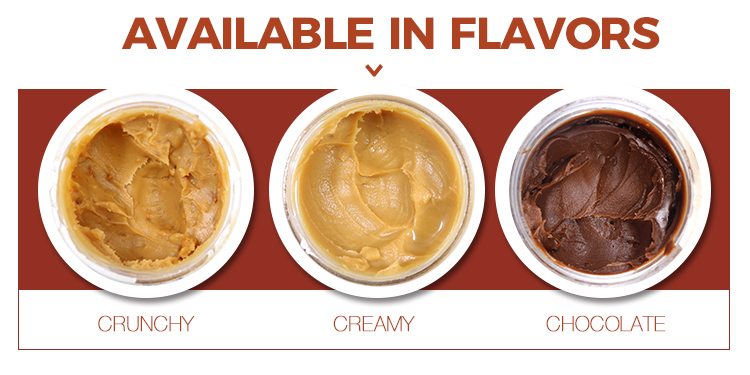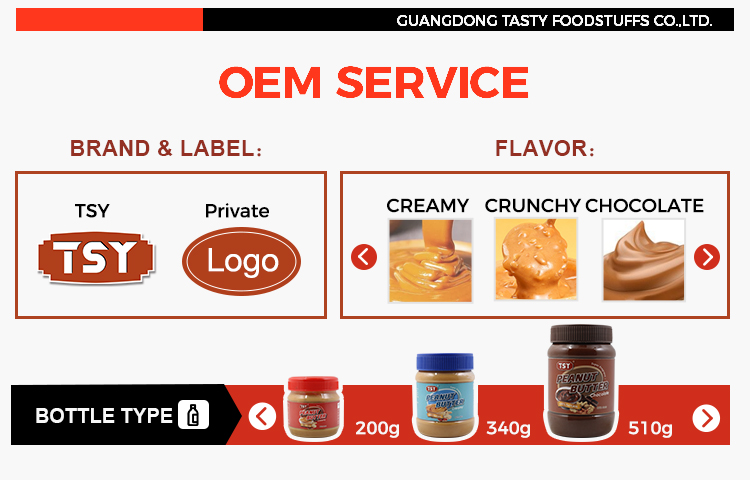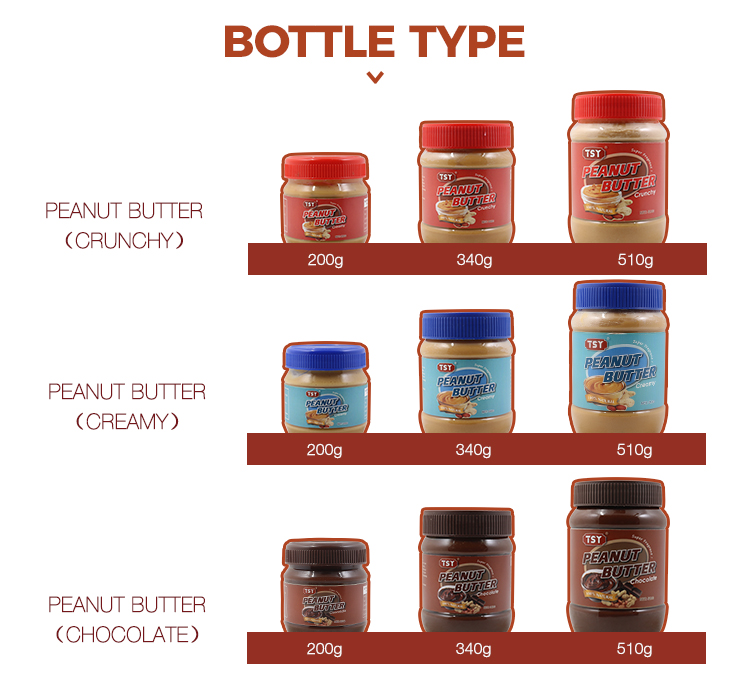Peanut butter is made from high-quality peanut rice and other raw materials, and the finished product is a hard and tough puree, with a strong aroma of fried peanuts. High-quality peanut butter is generally light beige, delicate in quality, rich in aroma and free of impurities. It can be consumed by the general population.
Peanut butter is divided into sweet and salty, which is a nutritious accompaniment food and is widely used in Western food.
| Flavor | With the sweetness of chocolate and the aroma of peanuts |
| Ingredient | Peanuts, Glycerol Monostearate, Salt,Sugar |
| Serving Suggestion | It can be eaten straight or used as a dipping sauce for bread and toast, and as a fillings for ice cream or other desserts. |
| Nutrition information typical values per 100g | Energy 2655kJ/635Kcal Protein 22.1g Total fat 50.8g Carbohydrate 23.5g Sodium 560mg |
| Shelf Life | 24 months |
| STORAGE: | Keep at room temperature and moisture proof storage. Please closed After opening use,and store in dry cool place. |
| Certificate | HACCP, BRC, IFS, HALAL, KOSHER, ISO |
Crunchy, creamy, and chocolate peanut butter are three distinct variations of peanut butter, each offering a unique taste and texture. Here are the key differences:

1. Crunchy Peanut Butter:
- Texture: Crunchy peanut butter contains small pieces of roasted peanuts, giving it a chunky or textured consistency.
- Taste: It has a classic peanut flavor with a noticeable crunch, which comes from the peanut pieces.
- Uses: Crunchy peanut butter is often used as a spread for sandwiches or toast, and its texture adds a satisfying element to recipes like cookies or granola bars.
2. Creamy Peanut Butter:
- Texture: Creamy peanut butter is smooth and lacks the crunchy peanut pieces found in the crunchy variety.
- Taste: It offers a consistent and creamy texture, and the taste is purely focused on the rich, nutty flavor of peanuts.
- Uses: Creamy peanut butter is versatile and is commonly used in sandwiches, baking, cooking, and as a base for various sauces and dips.
3. Chocolate Peanut Butter:
- Texture: Chocolate peanut butter combines peanut butter with cocoa or chocolate flavoring, resulting in a smoother texture compared to crunchy peanut butter.
- Taste: It has a distinct chocolate flavor in addition to the peanut taste, making it a sweet and nutty combination.
- Uses: Chocolate peanut butter is often used as a spread for bread, crackers, or fruit. It can also be a delicious ingredient in desserts, such as cookies, brownies, or as a filling for chocolate candies.
These variations of peanut butter cater to different preferences and culinary uses. While creamy peanut butter is a classic choice for its smoothness and versatility, crunchy peanut butter adds texture and bite. Chocolate peanut butter, on the other hand, adds a sweet and chocolaty twist to the traditional peanut flavor, making it a favorite for those who love the combination of chocolate and peanuts.
Peanut butter is made from high-quality peanut rice and other raw materials, and the finished product is a hard and tough puree, with a strong aroma of fried peanuts. High-quality peanut butter is generally light beige, delicate in quality, rich in aroma and free of impurities. It can be consumed by the general population.
Peanut butter is divided into sweet and salty, which is a nutritious accompaniment food and is widely used in Western food.
| Flavor | With the sweetness of chocolate and the aroma of peanuts |
| Ingredient | Peanuts, Glycerol Monostearate, Salt,Sugar |
| Serving Suggestion | It can be eaten straight or used as a dipping sauce for bread and toast, and as a fillings for ice cream or other desserts. |
| Nutrition information typical values per 100g | Energy 2655kJ/635Kcal Protein 22.1g Total fat 50.8g Carbohydrate 23.5g Sodium 560mg |
| Shelf Life | 24 months |
| STORAGE: | Keep at room temperature and moisture proof storage. Please closed After opening use,and store in dry cool place. |
| Certificate | HACCP, BRC, IFS, HALAL, KOSHER, ISO |
Crunchy, creamy, and chocolate peanut butter are three distinct variations of peanut butter, each offering a unique taste and texture. Here are the key differences:

1. Crunchy Peanut Butter:
- Texture: Crunchy peanut butter contains small pieces of roasted peanuts, giving it a chunky or textured consistency.
- Taste: It has a classic peanut flavor with a noticeable crunch, which comes from the peanut pieces.
- Uses: Crunchy peanut butter is often used as a spread for sandwiches or toast, and its texture adds a satisfying element to recipes like cookies or granola bars.
2. Creamy Peanut Butter:
- Texture: Creamy peanut butter is smooth and lacks the crunchy peanut pieces found in the crunchy variety.
- Taste: It offers a consistent and creamy texture, and the taste is purely focused on the rich, nutty flavor of peanuts.
- Uses: Creamy peanut butter is versatile and is commonly used in sandwiches, baking, cooking, and as a base for various sauces and dips.
3. Chocolate Peanut Butter:
- Texture: Chocolate peanut butter combines peanut butter with cocoa or chocolate flavoring, resulting in a smoother texture compared to crunchy peanut butter.
- Taste: It has a distinct chocolate flavor in addition to the peanut taste, making it a sweet and nutty combination.
- Uses: Chocolate peanut butter is often used as a spread for bread, crackers, or fruit. It can also be a delicious ingredient in desserts, such as cookies, brownies, or as a filling for chocolate candies.
These variations of peanut butter cater to different preferences and culinary uses. While creamy peanut butter is a classic choice for its smoothness and versatility, crunchy peanut butter adds texture and bite. Chocolate peanut butter, on the other hand, adds a sweet and chocolaty twist to the traditional peanut flavor, making it a favorite for those who love the combination of chocolate and peanuts.
According to the different tastes and qualities requirements of different customers, we offer Creamy Peanut Butter, Crunchy Peanut Butter, Chocolate Peanut Butter for choice.


| SPECIFIATION PER CTN | PACKS TYPE | CARTON SIZE (CM) | G.WEIGHT (KGS) /CTN |
| 200g*24tins | Plastic Bottle | 28*21.3*16.5 | 5.80 |
| 340g*24tins | Plastic Bottle | 30.4*23.2*20.7 | 9.40 |
| 510g*24tins | Plastic Bottle | 32.8*24.8*25.7 | 14.20 |
| 1kg*12tins | Plastic Bottle | 38.8*29*17 | 13.00 |
* If you have other needs, please consult us.
According to the different tastes and qualities requirements of different customers, we offer Creamy Peanut Butter, Crunchy Peanut Butter, Chocolate Peanut Butter for choice.


| SPECIFIATION PER CTN | PACKS TYPE | CARTON SIZE (CM) | G.WEIGHT (KGS) /CTN |
| 200g*24tins | Plastic Bottle | 28*21.3*16.5 | 5.80 |
| 340g*24tins | Plastic Bottle | 30.4*23.2*20.7 | 9.40 |
| 510g*24tins | Plastic Bottle | 32.8*24.8*25.7 | 14.20 |
| 1kg*12tins | Plastic Bottle | 38.8*29*17 | 13.00 |
* If you have other needs, please consult us.
The production process of peanut butter typically involves these steps:
1. Harvesting: Peanuts are harvested from fields when they are mature. The peanuts are usually pulled from the ground, dried, and then stored.
2. Shelling: After harvesting, the peanuts are shelled to remove the outer shell or hull. This can be done either manually or using machinery.
3. Roasting: The shelled peanuts are roasted to enhance flavor. Roasting can be done in large ovens, and it can vary in temperature and time depending on the desired flavor profile.
4. Cooling: After roasting, the peanuts are allowed to cool down. This step is essential before processing further.
5. Blanching: Some peanut butter varieties require blanching to remove the skins. This involves subjecting the peanuts to hot air, which causes the skins to loosen and be removed.
6. Grinding: The roasted (and optionally blanched) peanuts are ground into a paste. This is typically done using industrial grinders or mills. The grinding process can vary to achieve the desired texture, from smooth to chunky.
7. Additives: Depending on the brand and recipe, various additives such as salt, sugar, and stabilizers may be added to the peanut butter during the grinding process. These additives enhance flavor and extend shelf life.
8. Packaging: The final peanut butter paste is transferred into jars, cans, or other containers. These containers are sealed to ensure freshness and prevent spoilage.
9. Quality Control: Quality control checks are performed to ensure the product meets safety and quality standards. This includes testing for consistency, taste, and shelf life.
It's worth noting that the specific steps and methods can vary between different qualities or flavors, and some may use different variations of the process to create unique peanut butter products.
The production process of peanut butter typically involves these steps:
1. Harvesting: Peanuts are harvested from fields when they are mature. The peanuts are usually pulled from the ground, dried, and then stored.
2. Shelling: After harvesting, the peanuts are shelled to remove the outer shell or hull. This can be done either manually or using machinery.
3. Roasting: The shelled peanuts are roasted to enhance flavor. Roasting can be done in large ovens, and it can vary in temperature and time depending on the desired flavor profile.
4. Cooling: After roasting, the peanuts are allowed to cool down. This step is essential before processing further.
5. Blanching: Some peanut butter varieties require blanching to remove the skins. This involves subjecting the peanuts to hot air, which causes the skins to loosen and be removed.
6. Grinding: The roasted (and optionally blanched) peanuts are ground into a paste. This is typically done using industrial grinders or mills. The grinding process can vary to achieve the desired texture, from smooth to chunky.
7. Additives: Depending on the brand and recipe, various additives such as salt, sugar, and stabilizers may be added to the peanut butter during the grinding process. These additives enhance flavor and extend shelf life.
8. Packaging: The final peanut butter paste is transferred into jars, cans, or other containers. These containers are sealed to ensure freshness and prevent spoilage.
9. Quality Control: Quality control checks are performed to ensure the product meets safety and quality standards. This includes testing for consistency, taste, and shelf life.
It's worth noting that the specific steps and methods can vary between different qualities or flavors, and some may use different variations of the process to create unique peanut butter products.